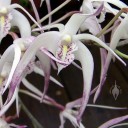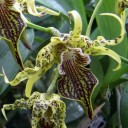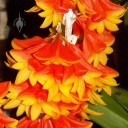Dendrobiums
Dendrobiums are one of the largest and most diverse orchid families. They include more than 1200 species and thousands more hybrids, with a vast range of colors, shapes, sizes, and growing conditions. The first 2 pictures below show the most common variety, the somewhat confusingly named Phalaenopsis-type Dendrobiums. No, they’re not Phals — they’re Dendrobiums whose blooms resemble Phals in shades of pink, purple, and white. These are popular as cut flowers and great in leis, but usually not fragrant.
Australian Dendrobiums, like the next 3 photos, are also popular. Many have rich fragrances. With their incredible diversity, Dendrobiums exemplify the deficiency of one-size-fits-all orchid care instructions. Some grow in hot, steamy jungles, while others grow on cold, windy mountains. As natives to a huge area, from India east to Japan, Australia, and the South Pacific, no single recipe can cover their care. However, they do share commonalities. Most want bright light with morning sun, good humidity, and winter dormancy.
Dendrobium plants come in many forms, but they most commonly have tall, thick plant stems called pseudobulbs or canes. In the next photo, lovely white and purple flowers bloom atop the canes of a Nobile type Dendrobium. Nobile types may drop all their leaves over winter, causing inexperienced growers to think a plant is dead and discard it. Ironically, some kinds flower after they drop their leaves, and their brilliant colors stand out on the bare canes. Other varieties have twisted petals or masses of brilliantly hued blooms.
There’s certainly no shortage of astonishing shapes and colors in the Dendrobium family. They’re true tropical beauties.
Explore posts in the same categories: Dormancy, Fragrant Orchids, Growing, Photos
Subscribe to the About Orchids Blog:
![]()












December 5th, 2011 at 10:48 pm
Great pictures! Did you grow them all yourself? I never knew how many different kinds there are.
December 6th, 2011 at 1:56 pm
No Ashley, I only grew one of these Dendrobiums (the white one in the fourth photo.) The rest are pictures from orchid shows and botanical gardens.
December 9th, 2011 at 10:30 am
[…] This stunning book …. makes a great holiday gift, and it’s much easier to wrap than a Dendrobium. […]
December 9th, 2011 at 7:32 pm
[…] Related Info: AboutOrchids – Dendrobiums […]
December 11th, 2011 at 4:04 pm
Your pictures are so beautiful. I don’t know how you do it again and again. I especially love the last row with all those bunches of tiny colorful flowers.
December 19th, 2011 at 12:18 am
Wow! I never knew there were so many different ones, and I still can’t figure out how to pronouce it.
January 20th, 2012 at 10:25 pm
Paphiopediliums and Miltonia are similar plants when we talk about repotting. You should do it once every 2-3 years. When you repot them you should not divide them into smaller division. The plants won’t react well to this, in fact this type of orchids don’t really like to be repotted. Use a medium grade fir bark with some extra additives like sphagnum moss and charcoal.
Orchid Food